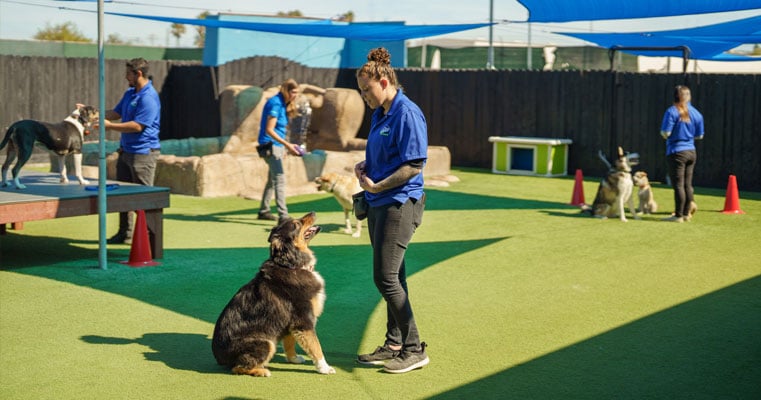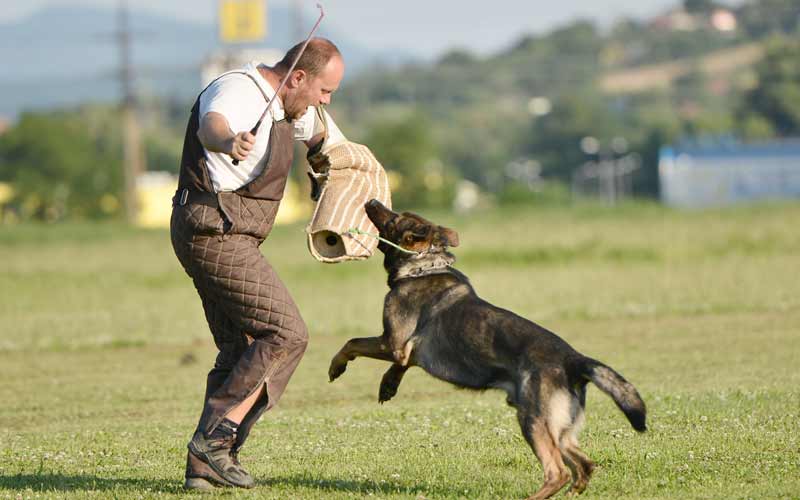Essential Tips for Successful Dog Training: A Guide for Animal Owners
Efficient dog training is a complex process that needs a critical technique tailored to both the animal's personality and the proprietor's objectives. Recognizing exactly how to browse these barriers can dramatically improve the training experience, inevitably transforming the partnership in between proprietor and pet.
Understanding Dog Actions
Understanding pet dog habits is essential for reliable training and promoting an unified connection between canines and their owners. dog training. Dogs interact primarily through body language, articulations, and actions, making it important for owners to translate these signals accurately.

Socializing plays a considerable duty in pet dog actions; exposure to various settings, people, and other pets can considerably affect a canine's character. Factors such as breed attributes and individual personality need to guide training methods, as some breeds may have particular behavioral traits that necessitate customized strategies. By comprehending these aspects, owners can create a helpful environment that urges favorable behavior, bring about successful training end results and a much deeper bond with their pet dogs.
Developing Regular Commands
Effective interaction with your pet dog begins with establishing regular commands. This fundamental element of training is critical for promoting understanding between you and your pet dog. Consistency in the commands you utilize makes sure that your canine can dependably link certain words or phrases with the preferred actions.
When selecting commands, choose clear, unique words that are easy to distinguish and say from one an additional. Stay clear of making use of similar-sounding commands that might puzzle your pet dog. Making use of "sit" and "stay" is suitable, however "rest" and "hit" could lead to misunderstandings.
In addition, keep the exact same tone and quantity for each command. Canines are sensitive to vocal signs, so varying your tone can produce complication.
It is equally important to guarantee that all member of the family get on the very same page pertaining to the commands utilized. A united front in command use will certainly stop combined signals and enhance the understanding procedure.
Positive Reinforcement Methods
The power of positive reinforcement in dog training hinges on its ability to motivate desired behaviors via benefits and appreciation. This method is based in the concept that behaviors adhered to by desirable results are more probable to be duplicated. By integrating favorable reinforcement right into your training routine, you can successfully shape your pet's behavior in a positive manner.
To carry out favorable support, it's vital to recognize what motivates your canine, whether it be deals with, playthings, or spoken appreciation. When your pet dog executes a wanted action, such as resting on command, instantly award them with a treat or love. This organization between the command and the favorable outcome reinforces their understanding.
It's essential to timing the incentives properly; delivering the reinforcement within seconds of the desired actions aids your pet dog make the connection (dog training). Furthermore, uniformity is vital-- ensure that all member of the family make use of the exact same commands and benefit systems to prevent complication

Gradually, you can minimize the frequency of deals with as your pet learns the actions, transitioning to praise or recurring benefits. This method not only cultivates a strong bond in between you and your dog however also advertises a positive knowing atmosphere, making training a delightful experience for both.
Socialization and Communication
Regularly exposing your dog to a range of environments, people, and various other pets is vital for their social advancement. Socialization ought to start early, preferably during the important window of 3 to 14 weeks, when puppies are most responsive to brand-new experiences. here are the findings Older pets can additionally profit from recurring socialization initiatives.
Introduce your dog to various setups, such as parks, pet-friendly stores, and urban locations. This direct exposure assists them adjust to numerous stimuli, decreasing anxiousness and anxiety reactions. Encourage positive interactions with various other canines and people, making sure that these encounters are regulated and risk-free to cultivate confidence.
Utilize structured playdates with well-mannered canines, as this can improve your pet's social skills and instruct them proper behavior. Obedience courses and training sessions additionally supply outstanding chances for socialization, allowing your pet dog to interact with others in a monitored environment.
Screen your dog's body language during interactions, as this will certainly assist you determine their comfort degree. Gradually boost exposure to more challenging circumstances while guaranteeing that each experience declares. A well-socialized dog is most likely to show well balanced habits, making them a happiness to have in any kind of setting.
Resolving Common Training Difficulties
Every canine owner will come across training difficulties at some time, regardless of their go to this web-site pet's age or socialization degree. Identifying usual concerns such as stubbornness, distractions, and fearfulness can assist in developing efficient approaches for improvement.

Gradually present diversions as the pet dog comes to be a lot more efficient in commands. Short, frequent training sessions are also reliable in keeping focus.
Terror can hinder a dog's knowing procedure. Gradual desensitization to the source of worry, combined with favorable reinforcement, browse around this site can aid relieve anxiety. Persistence is crucial; never ever compel a pet into a scenario that causes distress, as this might intensify the concern.
Inevitably, understanding and dealing with these common obstacles with a structured approach will certainly promote a more efficient training experience, reinforcing the bond between dog and proprietor while advertising reliable understanding.
Final Thought
In summary, effective canine training counts on a detailed understanding of canine habits, the facility of consistent commands, and the application of positive reinforcement techniques. Socializing plays a crucial role in creating well-adjusted pet dogs, while attending to common training difficulties calls for patience and versatility. By carrying out these important methods, family pet proprietors can promote a solid bond with their canines and promote desirable habits, inevitably causing an unified partnership between people and their canine buddies.
Comprehending dog behavior is essential for effective training and fostering a harmonious partnership between dogs and their owners.Socialization plays a considerable role in dog actions; exposure to various atmospheres, people, and various other pets can significantly affect a pet's personality.The power of positive reinforcement in dog training exists in its capacity to motivate wanted actions via benefits and appreciation. By including positive support right into your training routine, you can properly shape your canine's behavior in a useful fashion.
In summary, successful pet dog training depends on a comprehensive understanding of canine actions, the establishment of regular commands, and the application of positive support techniques.